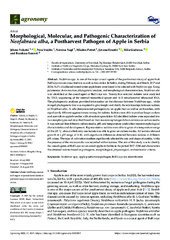Приказ основних података о документу
Morphological, Molecular, and Pathogenic Characterization of Neofabraea alba, a Postharvest Pathogen of Apple in Serbia
| dc.creator | Vukotić, Jelena | |
| dc.creator | Stojšin, Vera | |
| dc.creator | Nagl, Nevena | |
| dc.creator | Petreš, Mladen | |
| dc.creator | Hrustić, jovana | |
| dc.creator | Grahovac, Mila | |
| dc.creator | Tanović, Boris | |
| dc.date.accessioned | 2023-11-11T16:33:13Z | |
| dc.date.available | 2023-11-11T16:33:13Z | |
| dc.date.issued | 2022 | |
| dc.identifier.issn | 2073-4395 | |
| dc.identifier.uri | http://fiver.ifvcns.rs/handle/123456789/3984 | |
| dc.description.abstract | Neofabraea spp. is one of the major causal agents of the postharvest decay of apple fruit. Bull’s eye rot can cause fruit rot, as well as tree canker. In Serbia, during February and March, 2017 and 2018, 56.3% of collected stored rotten apple fruits were found to be infected with Neofabraea spp. Using polymerase chain reaction, phylogenetic analysis, and morphological characterization, Neofabraea alba was identified as the causal agent of Bull’s eye rot. Twenty-five selected isolates were analyzed by DNA sequencing of the internal transcribed spacer and 16 S mitochondrial ribosomal RNA. The phylogenetic analyses provided information on the distance between Neofabraea spp., while merged phylogenetic tree was required to give insight and clarify the relationships between isolates of Neofabraea alba. N. alba demonstrated pathogenicity on apple fruit as well as on branches, with significantly different aggressiveness among the isolates. Isolates were able to produce larger cankers and acervuli on apple branches with abundant sporulation All identified isolates were separated into two morphotypes and described based on their macromorphological characteristics on culture media. It was noticed that different culture media, pH, and temperature could affect macromorphological characteristics and development. Representative isolates were able to grow at a temperature range of 0 to 25 C, above which only one isolate was able to grow on culture media. All isolates showed growth at a pH range of 2–10, with significant differences detected between isolates at different pH values. The type of cultivation medium significantly affected the size and shape of conidia, while the presence of the microconidia was recorded within isolates. The aim of this study was to identify the causal agents of Bull’s eye rot on stored apples in Serbia in the period 2017–2018 and characterize the obtained isolates based on pathogenic, morphological, physiological, and molecular criteria. | sr |
| dc.language.iso | en | sr |
| dc.publisher | Basel : MDPI | sr |
| dc.relation | info:eu-repo/grantAgreement/MESTD/inst-2020/200117/RS// | sr |
| dc.rights | openAccess | sr |
| dc.rights.uri | https://creativecommons.org/licenses/by/4.0/ | |
| dc.source | Agronomy - Basel | sr |
| dc.subject | Neofabraea spp. | sr |
| dc.subject | apple postharvest pathogen | sr |
| dc.subject | Bull’s eye rot | sr |
| dc.subject | identification | sr |
| dc.subject | pathogens | sr |
| dc.subject | apples | sr |
| dc.subject | Serbia | sr |
| dc.title | Morphological, Molecular, and Pathogenic Characterization of Neofabraea alba, a Postharvest Pathogen of Apple in Serbia | sr |
| dc.type | article | sr |
| dc.rights.license | BY | sr |
| dc.citation.issue | 9 | |
| dc.citation.rank | M21 | |
| dc.citation.spage | 2015 | |
| dc.citation.volume | 12 | |
| dc.identifier.doi | 10.3390/agronomy12092015 | |
| dc.identifier.fulltext | http://fiver.ifvcns.rs/bitstream/id/9683/bitstream_9683.pdf | |
| dc.identifier.scopus | 2-s2.0-85138540778 | |
| dc.type.version | publishedVersion | sr |


